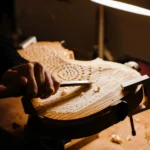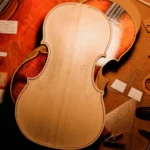Violin Strings History: How Violin Strings Were Made?
Back to BlogHave you ever wondered how violin strings were made in the past? In this article you will explore how these strings evolved, revealing centuries of craftsmanship and the pursuit of perfect sound.
Just like the violins themselves, violin strings have evolved dramatically over the centuries. Their story is one of constant innovation, reflecting humanity’s never-ending pursuit of perfect sound.
Violins as we know them emerged in 16th-century northern Italy, but their ancestors, like the pear-shaped lira and the two-stringed rabab, date back as far as the 9th and 11th centuries. Each stage of string making has shaped not only how violins sound, but also how musicians express themselves.
Let’s travel through the fascinating evolution of violin strings and see how craftsmanship and science continue to work together to define the voice of the violin.
How Violin Strings Were Made Through History:
According to research from the University of North Dakota, we can identify three main stages in the evolution of violin strings. Beginning even before the Egyptians, continuing through the Renaissance, and leading up to what we know and use today.
Gut Strings and Ancient Techniques
Long before the violin took shape, ancient musicians were already using animal intestines to create sound. Evidence from Egyptian hieroglyphs suggests that gut string making began over 6,000 years ago. These natural fibers became the standard for string instruments across Europe, prized for their warmth, flexibility, and expressive depth.
Surprisingly, gut strings aren’t made from cats (despite the term catgut). They’re traditionally crafted from sheep intestines, which are cleaned, stretched, dried, and twisted by hand. From the Renaissance through the early 20th century, gut strings were the standard for violins, violas, and cellos.
By the 17th century, makers discovered that winding gut with thin silver or copper wire could enhance resonance and projection. This innovation produced the first wound G strings, which became essential for achieving a fuller, more balanced tone.
How Gut Strings Were Made
The process of creating gut strings was complex and meticulous. According to Iva Pecotić’s research, the traditional method involved five stages:
- Recovery and selection of the intestines at the abattoir.
- Cleaning and dressing to remove fat and membranes.
- Stretching and twisting the gut into uniform strands.
- Drying and polishing to refine smoothness and tension.
- Wire winding, using metals like silver or copper for richer sound.
The result was a string capable of producing the rich, organic timbre that shaped centuries of Western music, from Bach to Brahms. Even today, many Baroque specialists still prefer gut strings for their unmistakable warmth and historical authenticity.
18th–19th Century
The late 18th century marked the first major transformation in string making. As violins evolved, with longer necks, steeper fingerboards, and greater string tension, luthiers needed stronger materials to withstand the added pressure.
By the early 1800s, wound gut strings had become the norm. The G string, wrapped in silver or copper, replaced its pure gut predecessor and produced a more resonant, powerful tone. Soon after, the D and A strings followed, though many violinists still preferred pure gut versions for their lyrical warmth.
This “first string revolution” redefined violin performance, enabling greater projection in larger concert halls and inspiring new playing techniques that suited the Romantic repertoire.
Steel Innovation
The next great leap came in the early 20th century, the second string revolution. Steel strings began to replace gut, initially for practical reasons. During World War I, gut became scarce, and violinists sought more durable alternatives.
In 1919, Thomastik-Infeld introduced the first steel E string, which quickly gained popularity for its stability and brightness. Soon after, D and A strings with metal winding appeared, and complete steel sets were experimented with for the first time.
By mid-century, string makers like Pirastro began producing hybrid strings. Gut cores wrapped in aluminum or silver. These offered the warmth of the gut with the reliability of steel.
Finally, in the 1970s, the synthetic era began. Thomastik-Infeld’s Dominant strings, made from nylon (Perlon), offered the tonal beauty of gut but with far greater stability. This innovation revolutionized violin playing once again, balancing expressive tone with durability and precise tuning.
Modern Violin Strings: Materials and Sound Profiles
Today, violinists and collectors can choose from two main types of strings, each offering a unique combination of tone, tension, and response.
Gut Strings
Made from sheep intestines, gut strings produce a warm, complex sound rich in overtones. They’re ideal for Baroque and Classical repertoire but are sensitive to temperature and humidity. Many professionals still use gut strings for historically informed performances.
Metal Strings
Built with solid or stranded steel cores, these strings deliver a bright, powerful sound and remain stable under all conditions. They’re durable and affordable, making them a popular choice for students, folk players, and electric violinists.
Modern string makers also experiment with materials like silver, tungsten, and titanium to fine-tune density and resonance, proving that violin string making today is both an art and a science.
Learn more: How to Choose the Right Violin Strings
How each string evolved
Each violin string has its own history, and its own role in shaping the instrument’s voice.
G String
From the late 1600s to the 1730s, G strings were wound with silver or copper wire to produce a fuller, more resonating sound. The sound of wound G strings was clearly superior to that of the pure gut, and by the 1730s pure gut had been totally replaced by wound gut.
D String
Until the end of World War I, pure gut D strings were the standard material for guitar strings. A method called demi-filée (half-wound) was developed in 18th-century France, which applied wire to the core of the string. The result was a very thick D string, which was prone to snapping and never became widespread. In the post-war period, aluminum began to be used to wind gut D strings fully. Today nearly all D strings are made from aluminum.
A String
In 1951, the A string was the last of the four strings to transition from a pure gut to a wound gut. Pirastro developed the first wound gut A string using aluminum. It took nearly ten years before it became standard. Pure gut A strings were standard until the advent of synthetic strings in 1970.
E String
The first E strings were made from sheep gut, but steel E strings emerged in the early 1900s. Steel E strings became popular during World War I when sheep gut was hard to come by. As an alternative to the gut, silk strings were used in cases of emergency until steel strings were
The Art and Science of Sound
No matter how advanced string technology becomes, the making of violin strings remains a true art form. Each instrument reacts differently to each material, making the search for the “perfect string” deeply personal.
There is no single best string, only the one that allows your violin to express its fullest voice. Gut or steel, every string connects centuries of craftsmanship with the modern musician’s touch.
At Amorim Fine Violins, we believe that tradition and innovation go hand in hand. From the legacy of Cremona to the precision of modern design, our luthiers combine history and passion to craft instruments that sing.
Visit us to explore our collection of violins and find the perfect match for your sound.









